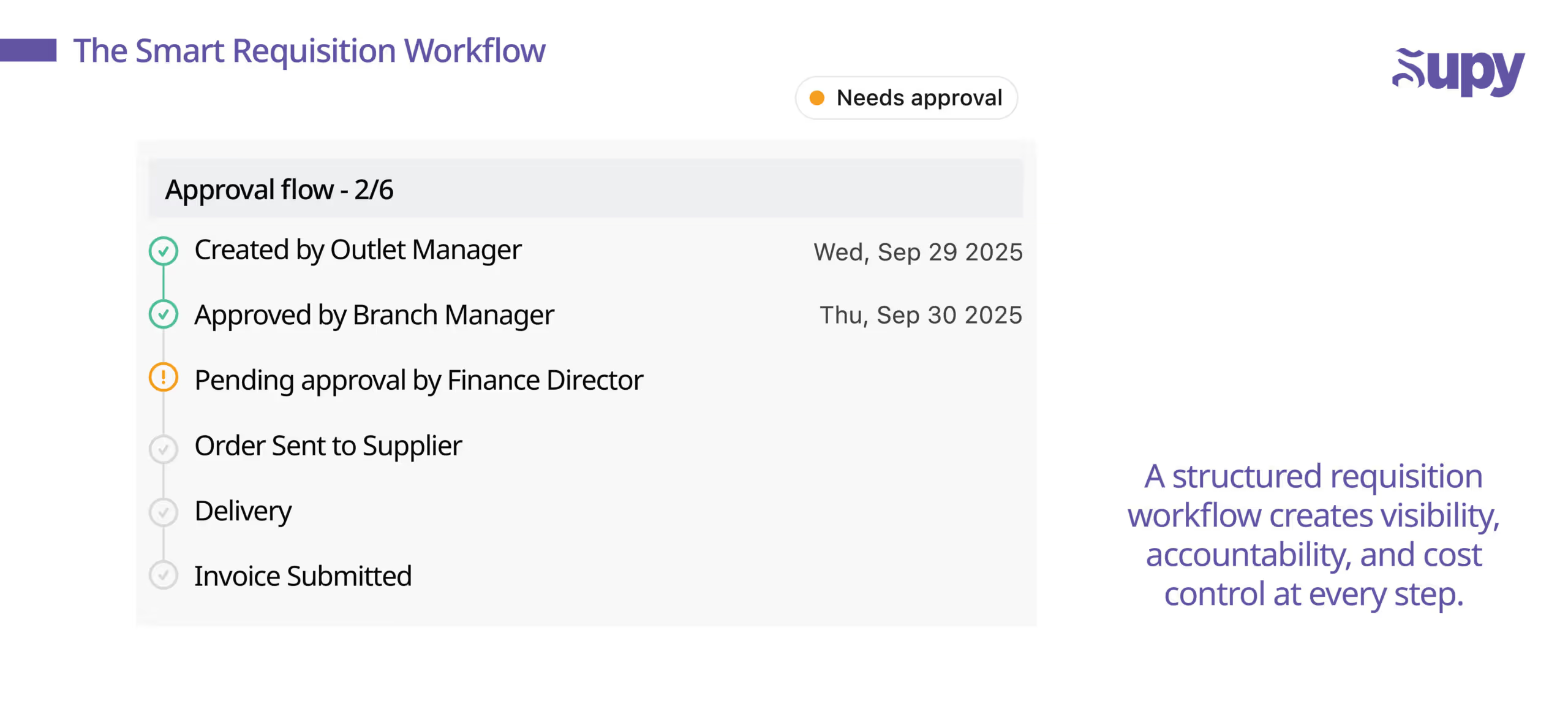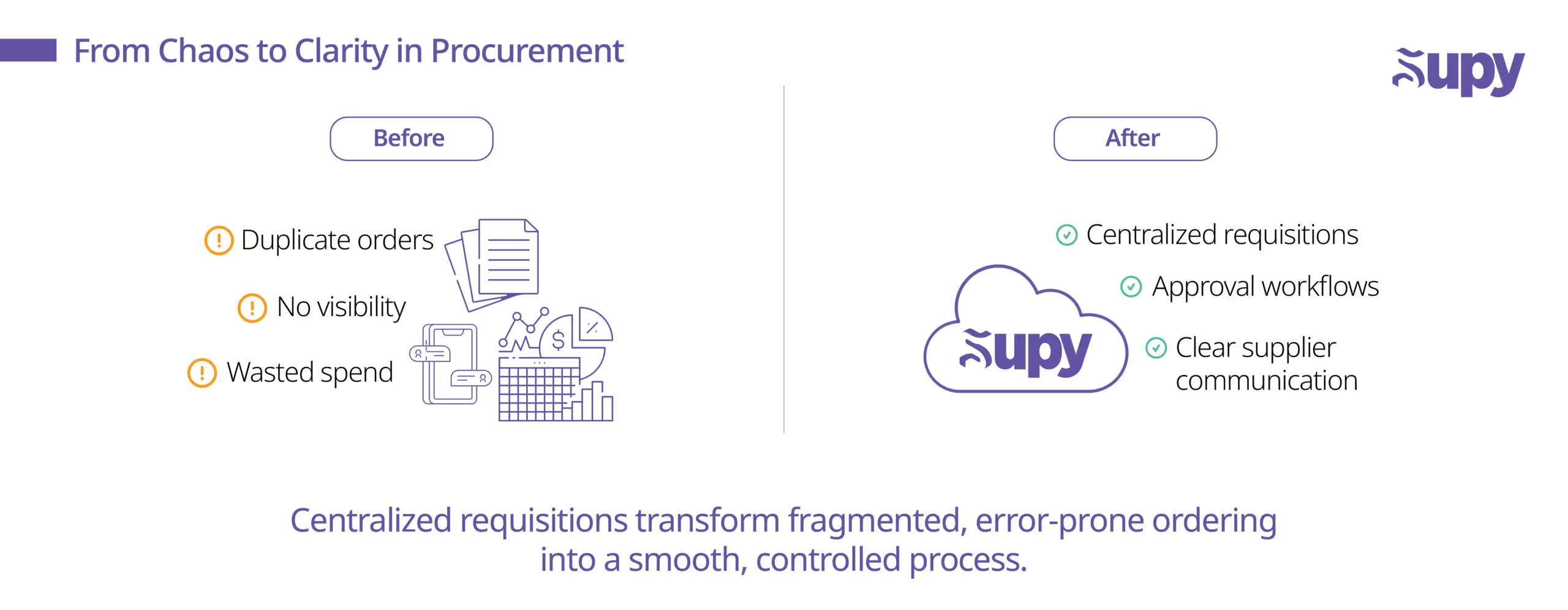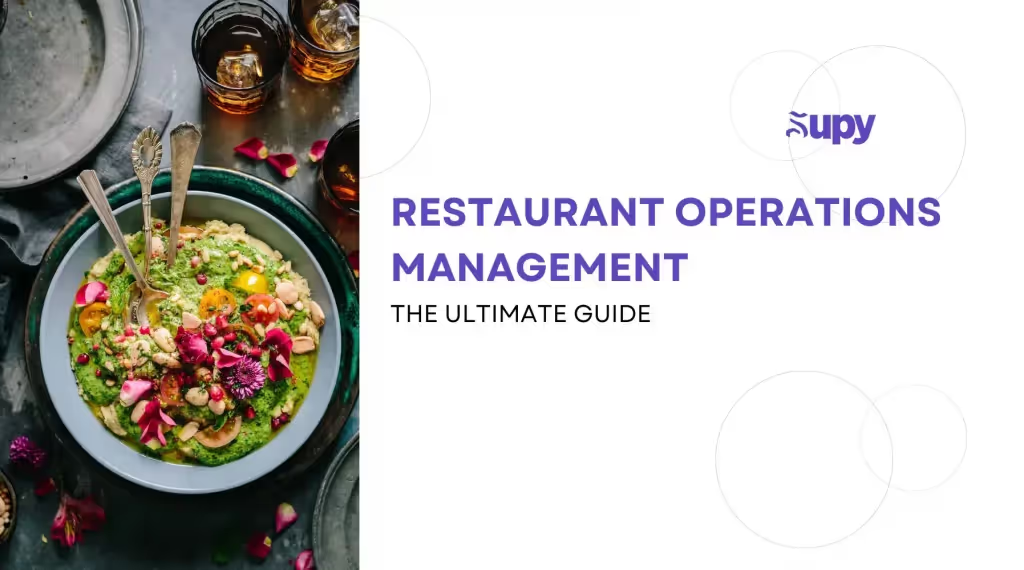Restaurant Requisitions: The Missing Link in Smarter Procurement

After decades in restaurant operations, I’ve learned that procurement can make or break the bottom line. Yet one often-overlooked process is key to consistency and cost control: requisitions. Simply put, a requisition is an internal purchase request – a formal step taken before placing any order. Neglecting requisitions is a recipe for waste and chaotic spending. In fact, businesses that fail to implement structured requisition and purchase order systems often end up with uncontrolled spending and financial errors. Smarter procurement starts with getting requisitions right.
What Exactly Are Restaurant Requisitions?
Think of a requisition as the official ask before any purchase in a restaurant. It’s an internal document (or digital form) that a team member (like a chef or a store manager) fills out to request goods or ingredients. The request goes to the appropriate approver – maybe a purchasing manager or a finance lead – who reviews it and approves (or denies) it. Only once approved does it become a purchase order that gets sent to a supplier for fulfillment.
In short, requisitions create a control point for every purchase. Rather than letting chefs call up vendors on a whim, you have a process that asks, “Do we really need this item, in this quantity, at this cost?” This ensures purchases are deliberate, properly authorized, and in line with your overall plan.
Why Requisitions Matter (and the Cost of Poor Practices)
Skipping or skimping on requisitions might seem like a way to move faster, but it almost always backfires. Without a requisition system, restaurants often face a host of inefficiencies and headaches:
- No visibility or record: When orders happen via text, phone, or ad-hoc emails, there’s no centralized log of what was ordered, when, or by whom. Important details get lost in WhatsApp chats or scattered across Excel sheets.
- Duplicate orders and stockouts: Lack of coordination leads to duplication and errors. One location might inadvertently order the same item twice, while another location forgets to order it at all. The result? Overstocking in one place (tying up cash and risking spoilage) and stockouts in another (leaving a chef empty-handed).
- Time-consuming admin work: Without a proper system, managers spend hours piecing together orders from different emails and spreadsheets. They might have to manually consolidate numbers just to figure out how much chicken or dairy the group needs in a week.
- Higher costs & waste: A sloppy ordering process often leads to last-minute “emergency” buys at retail prices because someone forgot to place an order. Meanwhile, others may over-order “just in case,” causing excess inventory that ends up spoiled.
- Weaker negotiating power: Without solid purchase data, you have less leverage to negotiate with suppliers.
I’ve witnessed this chaos first-hand. Before we implemented a proper system, our team was drowning in late-night WhatsApp orders and fragmented Excel files. Everyone was working hard, but the left hand (purchasing) didn’t know what the right hand (kitchen) was doing. The result was confusion, unexpected shortages, and wasted money.
Requisitions are the missing link in smarter restaurant procurement because they bring order to this chaos. By introducing a standardized request-and-approval step, you align your team on what to buy, when to buy it, and how much to spend – with full visibility along the way. It’s the foundation for consistency and cost control across all your locations.
Best Practices for a Smarter Requisition Workflow

Implementing requisitions doesn’t have to be complicated. Consider these best practices from industry leaders and my own experience:
- Standardize the process: Ensure every location follows the same requisition procedure. Whether you use a paper form or (ideally) a digital system, make it a rule that every purchase starts with a requisition. This creates accountability – team members know they must submit a request and get approval before any order is placed. Consistency is key: if five branches use five different methods, you’ll never get a handle on your spend.
- Set clear approval rules: Define who approves requisitions and set spending thresholds. For example, maybe the head chef can approve produce orders up to a certain amount, but larger purchases need sign-off from the procurement manager. The goal is oversight without bottlenecks. With an approval workflow in place, managers review requests for legitimacy and budget fit before they become POs, preventing frivolous or out-of-budget buys.
- Stay within budget: Requisition forms should include a field for budget or a required reason for the purchase. This forces managers to consider cost beforehand and allows the finance team to verify that each request fits within the location’s budget. Enforcing that every requisition aligns with budget limits helps control costs and stop rogue spending.
- Leverage technology: Use modern procurement software to automate the workflow. A good system can route requests to approvers, enforce approval limits, and provide a clear audit trail of all purchases.

By following these practices, you transform requisitions from a formality into a powerful management tool. You’ll gain a streamlined purchasing process with transparency and accountability at each step. Instead of scrambling to fix ordering mistakes, you can proactively manage purchasing and focus on higher-value activities.
Smarter Procurement with Supy’s Requisition Feature

Supy is a procurement platform designed to solve these exact challenges. It provides a single, unified system for all your requisitions and orders, eliminating the old mix of spreadsheets and text messages in favor of one streamlined workflow. With Supy’s Requisitions module, each outlet submits orders through the app, and those requests flow into a centralized dashboard for review and approval. No more guessing who ordered what – every request is logged with a clear audit trail, and no purchase moves forward without the proper approval. In short, Supy brings order and accountability to what used to be a fragmented process.
Because Supy connects requisitions with real-time [Inventory Management] module data, it also helps prevent over-ordering and stockouts. Users can see current stock levels as they place requests, and the system even suggests optimal order quantities based on past usage trends. All requisitions across your branches are visible in one place, giving management a bird’s-eye view of total demand. Duplicate orders can be caught and combined, and purchasing can be standardized across locations. This means you maintain full visibility and control – you know exactly what’s been requested, approved, and ordered at all times, across all sites.
Supy also streamlines the tail end of procurement: receiving orders and handling supplier invoices. Its AI-powered [Invoice Scanning] tool automatically reads and digitizes incoming invoices, matching them against the original orders. Any mismatch is flagged instantly – if a price changed or an item was missing, you’ll know right away. Supy can even generate [Credit Notes] for short shipments or overcharges with a click, so you recover money without tedious back-and-forth. By automating these steps, Supy ensures you only pay for what you actually received and agreed upon. The result is an end-to-end procurement workflow where every step – from requisition to invoice settlement – is optimized, visible, and under control.
Before vs. After: From Chaos to Clarity

To illustrate the impact, let’s compare an old-school procurement scenario with the new, streamlined way:
- Before (Old Way – Scattered orders, no visibility): Each restaurant outlet does its own thing. One chef sends a WhatsApp message to a supplier with an order, another emails an Excel sheet to the office, another makes a phone call to place an order verbally. There’s no single view of these orders. Mistakes are common – maybe two different people order the same item for different outlets (leading to double deliveries), while another item gets completely forgotten by everyone. One location can end up overstocked with tomatoes, while another is caught empty-handed and scrambling. Headquarters only finds out about the issues after the fact, and managers spend their time doing damage control with expensive last-minute purchases.
- After (New Way – Unified, streamlined requisitions): Now all outlets submit their orders through a unified requisition system (like Supy) by a set time each day. The central team has instant visibility on every request. They can approve and consolidate orders, catching any duplicates or oddities before orders go out. Once approved, purchase orders to suppliers are generated automatically. The next day, deliveries arrive matching those approved orders, and all stakeholders can see exactly what’s incoming and what was delivered. No surprises, no emergencies. It’s a coordinated workflow where every step is documented and visible, resulting in lower costs and far fewer headaches.
The difference is night and day. In the “before” scenario, you’re essentially flying blind and putting out fires. In the “after” scenario, you’re in control and proactively managing procurement. The stress level goes down, and consistency goes up – which ultimately means better margins and a healthier operation.
Ready to Transform Your Procurement?
For restaurant operators around the world, tightening up procurement through a strong requisition process is a game changer. Restaurant requisitions might have been the missing puzzle piece in your operations, but now you have the tools and know-how to fix that. By educating your team on best practices and deploying a platform like Supy, you can ensure that every order is the right order.
Ready to see the difference for yourself?
Supy’s Requisitions feature and end-to-end procurement solution can help you get there. It replaces outdated workflows with a streamlined system that saves time and money. Don’t settle for the status quo – take the next step toward smarter procurement. Book a Demo to see Supy in action, and discover how the missing link of requisitions can transform your restaurant’s profitability and efficiency. Your team will thank you for it.







